Time Travel
The concept of a time machine typically conjures up images of an implausible plot device used in a few too many science-fiction story-lines. But according to Albert Einstein's general theory of relativity, which explains how gravity operates in the universe, real-life time travel isn't just a vague fantasy.
Traveling forward in time is an uncontroversial possibility, according to Einstein's theory. In fact, physicists have been able to send tiny particles called muons, which are similar to electrons, forward in time by manipulating the gravity around them. That's not to say the technology for sending humans 100 years into the future will be available anytime soon, though.
1.by Worm-hole:
Since the 1930’s, physicists have speculated about the existence of "wormholes" in the fabric of space. Wormholes are hypothetical areas of warped spacetime with great energy that can create tunnels through spacetime. if traversable would allow a traveler to quickly move through great distances in space and also travel through time. The difficulty lies in keeping the wormhole open while the traveler makes his journey: If the opening snaps shut, he will never survive to emerge at the other end.
For years, scientists believed that the transit was physically impossible. But recent research, especially by the U.S. physicist Kip Thorne, suggests that it could be done using exotic materials capable of withstanding the immense forces involved. Even then, the time machine would be of limited use – for example, you could not return to a time before the wormhole was created. Using wormhole technology would also require a society so technologically advanced that it could master and exploit the energy within black holes.
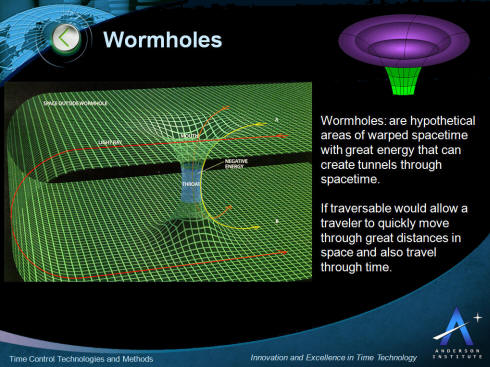
Spacetime can be viewed as a 2D surface (to simplify understanding) that, when 'folded' over, allows the formation of a wormhole bridge. A wormhole has at least two mouths that are connected to a single throat or tube. If the wormhole is traversable, then matter can 'travel' from one mouth to the other by passing through the throat. While there is no observational evidence for wormholes, spacetime containing wormholes are known to be valid solutions in general relativity.
The term wormhole was coined by the American theoretical physicist John Archibald Wheeler in 1957. However, the idea of wormholes had already been theorized in 1921 by the German mathematician Hermann Weyl in connection with his analysis of mass in terms of electromagnetic field energy.
This analysis forces one to consider situations...where there is a net flux of lines of force through what topologists would call a handle of the multiply-connected space and what physicists might perhaps be excused for more vividly terming a ‘wormhole’.
The key characteristics of the application of wormholes for time control and time travel are presented in the picture below. This is followed by more detail describing the science below.
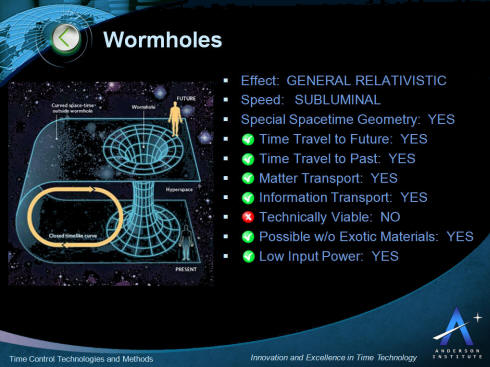
For years, scientists believed that the transit was physically impossible. But recent research, especially by the U.S. physicist Kip Thorne, suggests that it could be done using exotic materials capable of withstanding the immense forces involved. Even then, the time machine would be of limited use – for example, you could not return to a time before the wormhole was created. Using wormhole technology would also require a society so technologically advanced that it could master and exploit the energy within black holes.

Spacetime can be viewed as a 2D surface (to simplify understanding) that, when 'folded' over, allows the formation of a wormhole bridge. A wormhole has at least two mouths that are connected to a single throat or tube. If the wormhole is traversable, then matter can 'travel' from one mouth to the other by passing through the throat. While there is no observational evidence for wormholes, spacetime containing wormholes are known to be valid solutions in general relativity.
The term wormhole was coined by the American theoretical physicist John Archibald Wheeler in 1957. However, the idea of wormholes had already been theorized in 1921 by the German mathematician Hermann Weyl in connection with his analysis of mass in terms of electromagnetic field energy.
This analysis forces one to consider situations...where there is a net flux of lines of force through what topologists would call a handle of the multiply-connected space and what physicists might perhaps be excused for more vividly terming a ‘wormhole’.
The key characteristics of the application of wormholes for time control and time travel are presented in the picture below. This is followed by more detail describing the science below.

Definition
The basic notion of an intra-universe wormhole is that it is a compact region of spacetime whose boundary is topologically trivial but whose interior is not simply connected. Formalizing this idea leads to definitions such as the following, taken from Matt Visser's Lorentzian Wormholes.If a Minkowski spacetime contains a compact region Ω, and if the topology of Ω is of the form Ω ~ R x Σ, where Σ is a three-manifold of nontrivial topology, whose boundary has topology of the form dΣ ~ S2, and if, furthermore, the hypersurfaces Σ are all spacelike, then the region Ω contains a quasi-permanent intra-universe wormhole.
Characterizing inter-universe wormholes is more difficult. For example, one can imagine a 'baby' universe connected to its 'parent' by a narrow 'umbilicus'. One might like to regard the umbilicus as the throat of a wormhole, but the spacetime is simply connected.
Schwarzschild wormholes
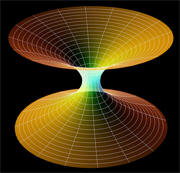 Diagram of a Schwarzschild Wormhole |
Before the stability problems of Schwarzschild wormholes were apparent, it was proposed that quasars were white holes forming the ends of wormholes of this type.
While Schwarzschild wormholes are not traversable, their existence inspired Kip Thorne to imagine traversable wormholes created by holding the 'throat' of a Schwarzschild wormhole open with exotic matter (material that has negative mass/energy).
Traversability
Wormholes would act as shortcuts connecting distant regions of space-time. By going through a wormhole, it might be possible to travel between the two regions faster than a beam of light through normal space-time. |
Wormholes connect two points in spacetime, which means that they would in principle allow travel in time, as well as in space. In 1988, Morris, Thorne and Yurtsever worked out explicitly how to convert a wormhole traversing space into one traversing time.[4] However, it has been said a time traversing wormhole cannot take you back to before it was made but this is disputed.
Faster-than-light travel
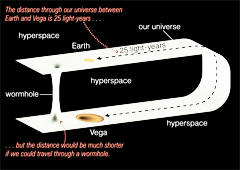 |
Time travel
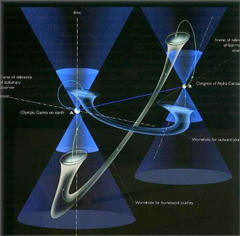 |
For example, consider two clocks at both mouths both showing the date as 2000. After being taken on a trip at relativistic velocities, the accelerated mouth is brought back to the same region as the stationary mouth with the accelerated mouth's clock reading 2005 while the stationary mouth's clock read 2010. A traveler who entered the accelerated mouth at this moment would exit the stationary mouth when its clock also read 2005, in the same region but now five years in the past. Such a configuration of wormholes would allow for a particle's world line to form a closed loop in spacetime, known as a closed timelike curve.
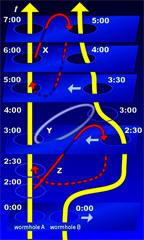 |
Metrics
Theories of wormhole metrics describe the spacetime geometry of a wormhole and serve as theoretical models for time travel. An example of a (traversable) wormhole metric is the following:One type of non-traversable wormhole metric is the Schwarzschild solution:

2.by Black-hole:
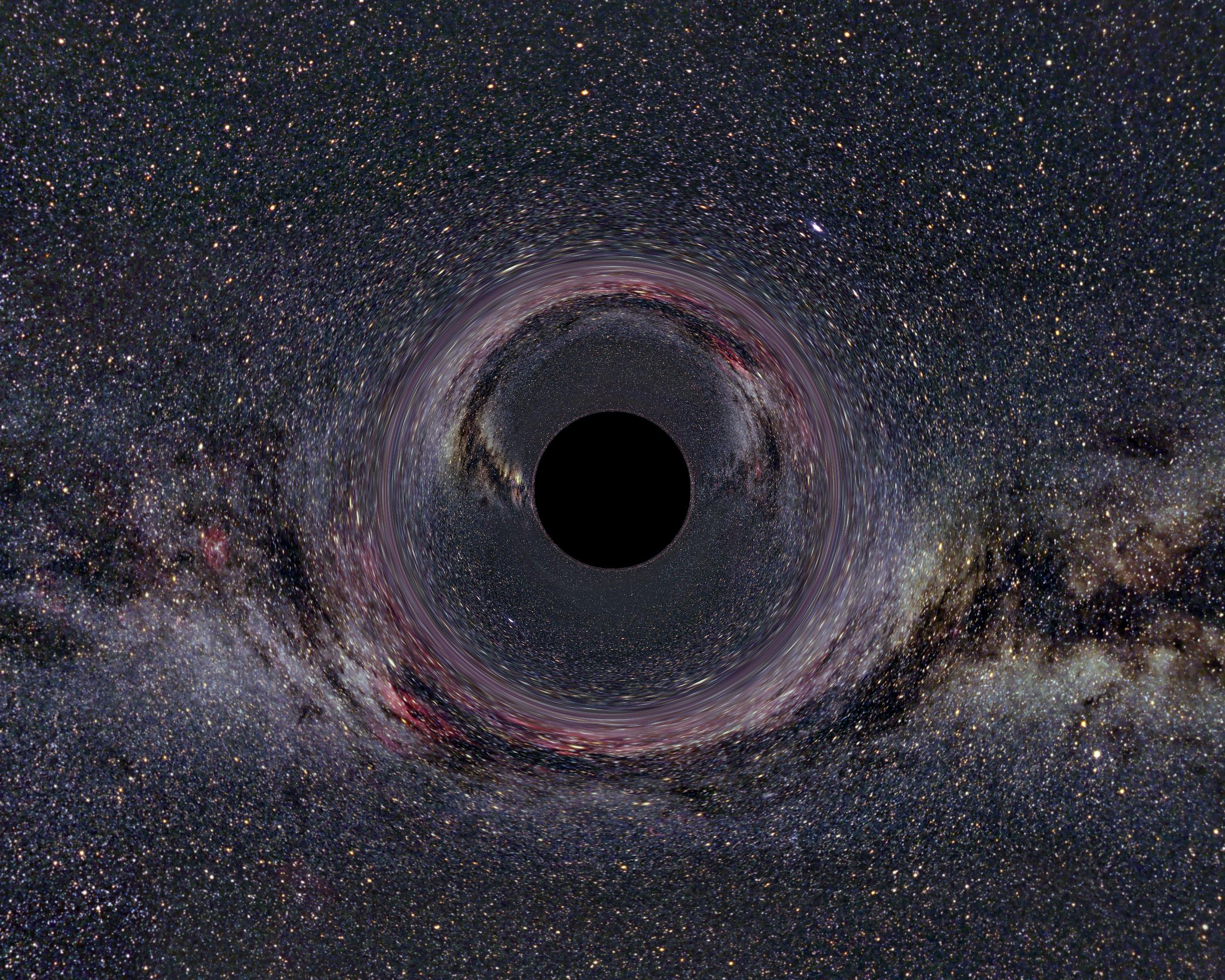
Black holes can be used to travel into the future only. So far as we know, our universe prohibits traveling into the past.
According to Einstein's theory of general relativity, and to experimental evidence here on earth assembled by Harvard physicists Pound and Rebka, in the presence of a gravitational field, an external observer would see a clock in a strong gravitational field tick more slowly. This is analogous to the famous time dilation effect in special relativity, except that in the 'gravitational redshift' effect no motion between the observer outside the gravitational field and the clock located within the field, is required.
What this means is that if you were traveling into a strong gravitational field and sending out pulses of light every second, an observer watching these signals from a great distance would see the interval between the pulses increase from seconds to minutes and then hours as the field got stronger and stronger.
Black holes are fantastic sources of very strong gravitational fields. What a distant observer would see as your clock got closer to the so-called Event Horizon of the black hole is that the pulse interval would increase without limit from one second to one month and longer. The frequency of the light pulses would also get longer as the light lost more and more energy struggling to get out from the vicinity of the black hole. As your friend finally entered the black hole by passing across its event horizon, the last photon capable of making it to infinity is emitted at almost infinite redshift, meaning that if you originally emitted a gamma ray with an energy of 1000 billion electron volts, buy the time your friend received it far away, it would have lost enough energy to become a radio photon with an energy of 0.00001 electron volts! So, if it took your friend 1000 hours to travel from where you are to the black hole, the last photon he sent you just before entering the black hole, would arrive at your location 1000 hours from now, but when you looked at the interval between the last two pulses he sent, you would see that they are not the one second interval you started out with, but say 1 or 2 minutes or more. But here's the rub. According to your infalling friend, he/she is still sending the pulses out once each second!
In other words, one second to your friend falling into a black hole is several minutes to you and, in essence, your friend is aging more slowly than you and is traveling into the future faster than you are. If he/she could manage to put on the breaks just before crossing over the Event Horizon and escape to rejoin you, you would note that his/her clock reads a much earlier time than your clock. To your friend, only 2000 hours may have elapsed, however, YOUR clock would read perhaps 10000 hours or several weeks have elapsed depending how close to the Event Horizon your friend could get before escaping. The tidal gravitational forces are enormous near small black holes the mass of the sun, so your friend would be shredded into spaghetti within a few hundred miles of the Horizon. For supermassive black holes of several billion solar masses, however, the tidal forces near the Horizon are very small and survivable. This means you could accidently find yourself passing across this one-way barrier, and only realize your mistake when you tried to escape and found it impossible.
In principle, if you could get within a few millimeters of an Event Horizon before escaping, you could essentially time travel years or millenia into the future as measured by outside clocks. According to your clock, however, perhaps only a few hour or days actually elapsed.
Note, all of the above numbers are pretty darn approximate and are given to qualitatively show the magnitudes of the effects.
3.by travelling at the speed of light:
In the early 1900s, scientists held firm to the Newtonian view of the world. Then a German-born mathematician and physicist by the name of Albert Einstein came along and changed everything. In 1905, Einstein published his theory of special relativity, which put forth a startling idea: There is no preferred frame of reference. Everything, even time, is relative. Two important principles underpinned his theory. The first stated that the same laws of physics apply equally in all constantly moving frames of reference. The second said that the speed of light -- about 186,000 miles per second (300,000 kilometers per second) -- is constant and independent of the observer's motion or the source of light. According to Einstein, if Superman were to chase a light beam at half the speed of light, the beam would continue to move away from him at exactly the same speed.
These concepts seem deceptively simple, but they have some mind-bending implications. One of the biggest is represented by Einstein's famous equation, E = mc², where E is energy, m is mass and c is the speed of light. According to this equation, mass and energy are the same physical entity and can be changed into each other. Because of this equivalence, the energy an object has due to its motion will increase its mass. In other words, the faster an object moves, the greater its mass. This only becomes noticeable when an object moves really quickly. If it moves at 10 percent the speed of light, for example, its mass will only be 0.5 percent more than normal. But if it moves at 90 percent the speed of light, its mass will double.
As an object approaches the speed of light, its mass rises precipitously. If an object tries to travel 186,000 miles per second, its mass becomes infinite, and so does the energy required to move it. For this reason, no normal object can travel as fast or faster than the speed of light.
We covered the original question, but what if we tweaked it to say, "What if you traveled almost as fast as the speed of light?" In that case, you would experience some interesting effects. One famous result is something physicists call time dilation, which describes how time runs more slowly for objects moving very rapidly. If you flew on a rocket traveling 90 percent of light-speed, the passage of time for you would be halved. Your watch would advance only 10 minutes, while more than 20 minutes would pass for an Earthbound observer.
You would also experience some strange visual consequences. One such consequence is called aberration, and it refers to how your whole field of view would shrink down to a tiny, tunnel-shaped "window" out in front of your spacecraft. This happens because photons (those exceedingly tiny packets of light) -- even photons behind you -- appear to come in from the forward direction. In addition, you would notice an extreme Doppler effect, which would cause light waves from stars in front of you to crowd together, making the objects appear blue. Light waves from stars behind you would spread apart and appear red. The faster you go, the more extreme this phenomenon becomes until all visible light from stars in front of the spacecraft and stars to the rear become completely shifted out of the known visible spectrum (the colors humans can see). When these stars move out of your perceptible wavelength, they simply appear to fade to black or vanish against the background.
1.
2.
3.
4.
Complete:
4.Into The Universe With Stephen Hawking: Time Travel
No comments:
Post a Comment